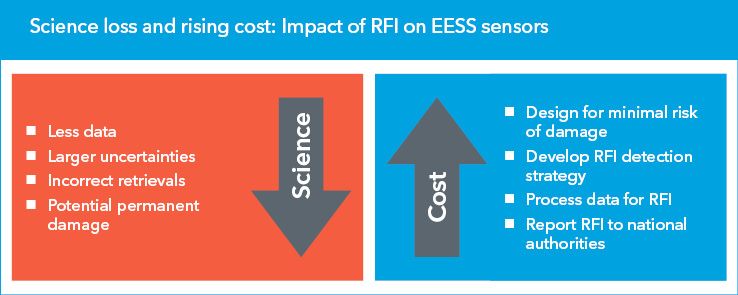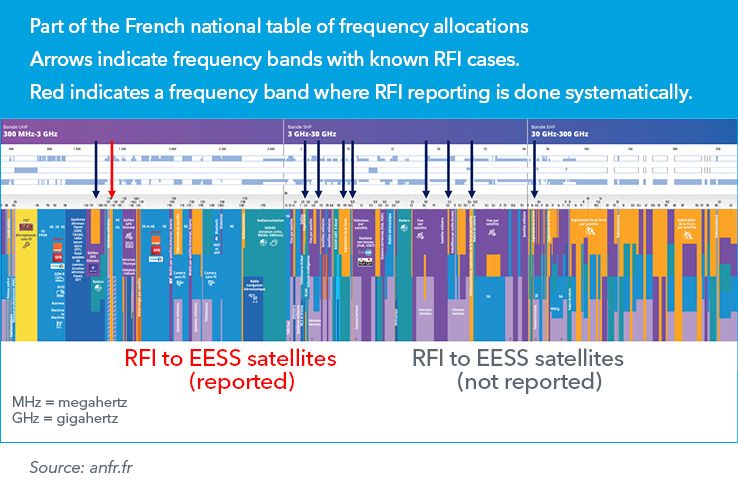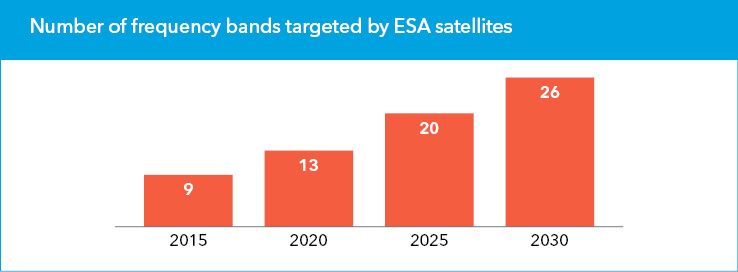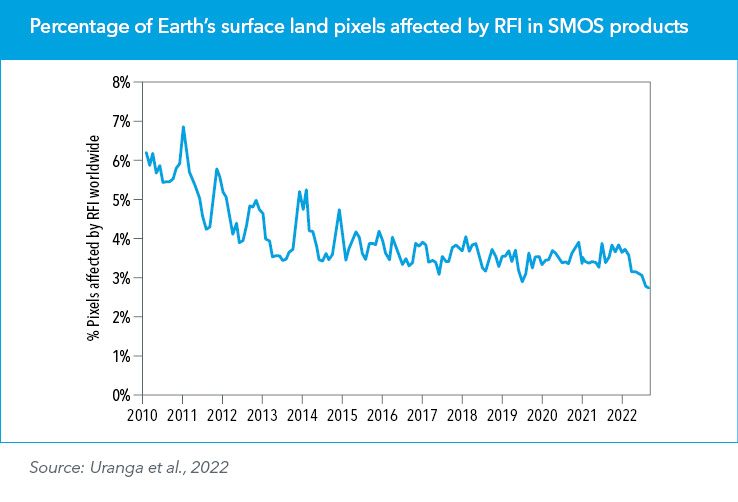
Radio-frequency interference in Earth-observation measurements


Yan Soldo, Frequency Management and Technology Engineer,
European Space Agency (ESA)
Radio-frequency interference (RFI) poses several challenges for the Earth exploration-satellite service (EESS), which relies on precise sensors affected by radio waves. Typically, the presence of RFI will either completely prevent measurements, cause larger uncertainties (if the RFI is correctly identified), or introduce measurement errors. Measurement errors tend to happen at lower RFI levels, which are more difficult to identify [Oliva et al., 2016].
Strong RFI may also damage satellite receivers, resulting in permanent losses of science data. In addition, the need to account for RFI adds to design and operational costs for EESS sensors.
Need for regulation protection and regulatory actions
Software or hardware improvements can reduce, but not eliminate, the impact of RFI on science data.
Even a perfect RFI detection algorithm leaves Earth-observation satellite networks exposed to some data loss and measurement uncertainties. Therefore, regulatory protection and regulatory actions, including RFI reporting [Pedro et al., 2022], are needed to protect science measurements that are vital for environmental and climate studies, as well as for meteorology.

RFI contamination of EESS sensors
Today, many EESS sensors are affected by RFI. Some examples are provided in Draper, 2018, and in the dedicated webpage from the Space Frequency Coordination Group (SFCG). However, few operators can consistently detect and locate sources of interference, and even fewer have taken steps to report RFI to their appropriate national regulatory authorities.
The next figure shows a portion of France’s national table of frequency allocations. The arrows indicate frequency bands with documented cases of EESS sensors being affected by RFI (although RFI may be present in even more bands), while the red arrow indicates the 1400–1427 MHz band, the only band where there have been systematic RFI reports.

As this figure shows, RFI affecting EESS sensors is largely under-reported. This is partly due to the complexity of detecting RFI, but mostly because the footprint of EESS sensors — meaning the area they observe at each instant — is tens of kilometres wide, which is too large for any practical action on the ground.
Algorithms developed in recent years, however, can locate RFI sources with accuracies finer than the size of the footprint, typically within a few kilometres, which is sufficient for national regulatory authorities to identify the source of the RFI reported by EESS sensors.
Expected trends
Looking ahead, RFI is likely to become an even bigger issue. Current plans are that Earth-observation satellites will become more present in the spectrum, both in terms of number of satellites and frequency bands observed.
At the same time, many other services are planning to expand their presence in the spectrum. For example, according to the American Institute of Aeronautics and Astronautics (AIAA), the private satellite sector is planning to deploy tens of thousands of satellites; and a report from global mobile telecom industry association GSMA forecasts 37.4 billion Internet-of-Things connections by 2030.

Impact of reporting RFI
The 1400–1427 MHz band is one case where the RFI environment has slightly improved rather than degraded in recent years. RFI was first noticed in this band in 2010 by the European Space Agency (ESA) Soil Moisture and Ocean Salinity (SMOS) mission. This triggered concerted efforts to detect, locate and report the sources of interference.
The continuation of these endeavours over the years has led to a gradual reduction of RFI contamination (see figure), demonstrating the effectiveness of RFI reporting.

Future of RFI reporting
Space agencies, recognizing this as a powerful tool to protect and maintain science measurements, are striving to improve their RFI reporting capacity.
Future ESA missions, such as Metop-SG and the Copernicus Imaging Microwave Radiometer (CIMR), will carry hardware dedicated to RFI processing, and work is currently ongoing to improve RFI detection and monitoring capabilities. This should lead, in the coming years, to more systematic reporting of RFI sources affecting EESS sensors.
Conclusions
Cases of RFI have been documented in several bands, and RFI is deemed an increasing concern as many terrestrial and spaceborne services plan to rely more heavily on the spectrum.
Therefore, EESS sensors must be readied for the presence of RFI. A key part of this preparation is to set in place a strategy that allows systematic identification and reporting of RFI to national regulatory authorities. This has been implemented in one band — with positive results — and more work is currently underway to improve RFI reporting, including in additional bands.
Download your copy of the ITU News Magazine: Science services.
Header image credit: Adobe Stock
